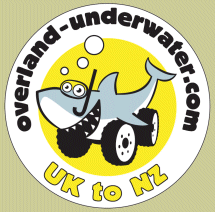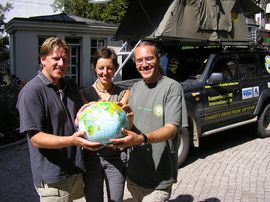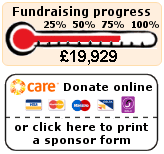| Final Statistics: Alex & Maz | Total distance: 93,550km |
| Furthest Point: Rotorua, NZ | Now settled in Sydney, Australia |
| Final Statistics: Martin | Total distance: 79,698km |
| Furthest Point: Hobart, Australia | Now settled in Bristol, UK |
Visit to Care International Indonesia's Project to Improve Child Health in the Jakarta Suburbs
Indonesia, Country 24, Diary entry 4th August 2006, Total distance in Indonesia: 6750km (estimated)
As I hadn't managed to visit the Care International projects with Alex and Maz in Thailand I was particularly keen to arrange to visit something in Indonesia as it seemed it would be the last opportunity for me on this trip! After many email discussions with the Care International Indonesia staff we settled upon the BERSIH project in the Tangerang district in the Jakarta suburbs, and finally the day arrived and I met with Frank Page, an American living and working in Indonesia for 16 years and currently Urban Programme Manager for Care International Indonesia (CII). He explained to me the BERSIH project.
BETTER GOVERNANCE TO REVITALISE URBAN ENVIRONMENTS AND IMPROVE MATERNAL CHILD HEALTH AND NUTRITION PROGRAM (BERSIH)
Indonesia is the fourth most populous country in the world after China, India and the USA but Java alone is home to over half of this population making its population density four times that of the UK and twice that of the Netherlands, Europe's most densely populated country.
Like other countries throughout the world, Indonesia is steadily urbanising and it is estimated that over 60% of Indonesians will be living in urban areas by 2025. Often the new arrivals to cities live in the poorest communities, with inadequate and unsanitary living conditions and poor health status. Currently it is estimated that up to 25% of Jakarta residents reside in poor urban neighbourhoods (kampongs).
The living conditions for mothers and children in these areas are poor. The baseline survey conducted by CARE International Indonesia found that 31% of the children over 6 months and under 5 years of age were either moderately or severely underweight and 20% of children in this age group were stunted. Sixteen percent of the children under five had suffered from diarrhoea in the past two weeks, a rate that is higher than the national average. For all of this data, children between 6 and 18 months appear to be the most vulnerable.
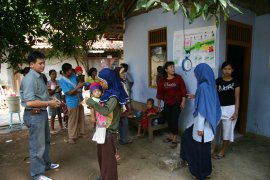 CII's response to this situation has been to set up a project working in twenty urban villages in the Tangerang district of Jakarta aiming to improve the nutritional status of children under five years of age and reduce the incidence of diarrhoea among the same group of children.
CII's response to this situation has been to set up a project working in twenty urban villages in the Tangerang district of Jakarta aiming to improve the nutritional status of children under five years of age and reduce the incidence of diarrhoea among the same group of children.
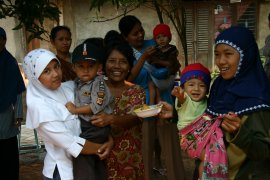 I transferred to the Tangerang office and there I was met by Maria Aruan and Ronald Sianipar who are both project managers working on this project. They kindly took me to two different villages to show me the work in progress.
I transferred to the Tangerang office and there I was met by Maria Aruan and Ronald Sianipar who are both project managers working on this project. They kindly took me to two different villages to show me the work in progress.
In the first village they had set up a health post and weighed 49 children and found 21 to be underweight and of those 7 were severely malnourished. Taking the 9 neediest children first they run a programme of education of the mothers in nutrition knowledge and practices.
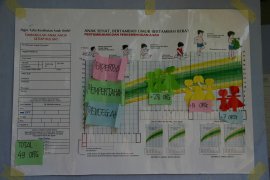 The solution to the malnourishment is not a simple case of telling them to eat more vitamins. In most cases the family is living on $1-2 per day and they simply cannot afford expensive diets, and in any case they can only eat the food that is available in the local markets. The approach taken to resolve the problem is called the Positive Deviance approach. If 30% of children are malnourished then that means there are 70% that are OK, so local health volunteers monitor the nutritional practices of the mothers of these well nourished children and then teach those practices to other neighbourhood mothers whose children are underweight. This means that the advice that the programme is providing is practical and can realistically be adopted by the families of the malnourished children.
The solution to the malnourishment is not a simple case of telling them to eat more vitamins. In most cases the family is living on $1-2 per day and they simply cannot afford expensive diets, and in any case they can only eat the food that is available in the local markets. The approach taken to resolve the problem is called the Positive Deviance approach. If 30% of children are malnourished then that means there are 70% that are OK, so local health volunteers monitor the nutritional practices of the mothers of these well nourished children and then teach those practices to other neighbourhood mothers whose children are underweight. This means that the advice that the programme is providing is practical and can realistically be adopted by the families of the malnourished children.
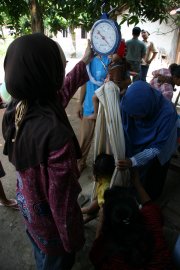 CII trains the health volunteers in the skills needed to run and manage the health posts. These skills include weighing and recording children, providing good information on diet, referring severely malnourished to the community health centre, reporting to health authorities, and self monitoring. In addition, CII provides scales and growth cards to the health posts.
CII trains the health volunteers in the skills needed to run and manage the health posts. These skills include weighing and recording children, providing good information on diet, referring severely malnourished to the community health centre, reporting to health authorities, and self monitoring. In addition, CII provides scales and growth cards to the health posts.
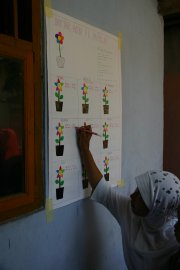 My visit to the village coincided with the final day of a 30 day programme to improve the nourishment of these 9 children and I could see colourful charts on the walls showing records of the children's attendance, how much they had eaten each day etc. and I was there for the traumatic episode of the final weighing. In the majority of cases a good weight increase was recorded and using an international standard chart of child's age against ideal weight, several of the children were seen to be in the yellow "moderately malnourished" zone - but these children were mostly in the red "severely malnourished" zone 30 days ago. This was a very encouraging sign of the programme's effectiveness.
My visit to the village coincided with the final day of a 30 day programme to improve the nourishment of these 9 children and I could see colourful charts on the walls showing records of the children's attendance, how much they had eaten each day etc. and I was there for the traumatic episode of the final weighing. In the majority of cases a good weight increase was recorded and using an international standard chart of child's age against ideal weight, several of the children were seen to be in the yellow "moderately malnourished" zone - but these children were mostly in the red "severely malnourished" zone 30 days ago. This was a very encouraging sign of the programme's effectiveness.
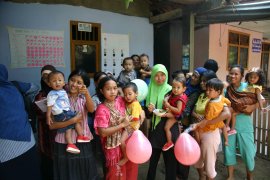 In addition, again based on the positive deviance approach, these health centres teach and support pregnant women with good antenatal care programmes by supporting them to take iron supplements and get routine checkups. The programme will support lactating mothers to practice early initiation of breast feeding, exclusive breast feeding for children under 6 months old and then good complementary and weaning practices - in order to prevent children from becoming undernourished during that critical 6 to 18 month age period.
In addition, again based on the positive deviance approach, these health centres teach and support pregnant women with good antenatal care programmes by supporting them to take iron supplements and get routine checkups. The programme will support lactating mothers to practice early initiation of breast feeding, exclusive breast feeding for children under 6 months old and then good complementary and weaning practices - in order to prevent children from becoming undernourished during that critical 6 to 18 month age period.
In the second village I visited I was taken to visit some of the houses where Care had contributed towards the installation of latrine systems as a way of making people's lives more hygienic and reducing diarrhoea.
Interestingly on the edge of the village was a public toilet block which had been long left to dereliction. Installed by the government many years ago, its use had never been embraced by the community who felt that a public system was less hygienic than using the local fields and streams, and nobody wanted to take responsibility for maintenance.
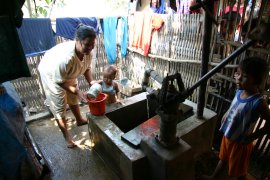 Care's approach is to work with a committee formed from the local communities to agree a solution that is appropriate to everyone. It was found that installing toilets into people's homes, or adding an extension to the building, was the most suitable approach as people felt they could maintain their own system.
Care's approach is to work with a committee formed from the local communities to agree a solution that is appropriate to everyone. It was found that installing toilets into people's homes, or adding an extension to the building, was the most suitable approach as people felt they could maintain their own system.
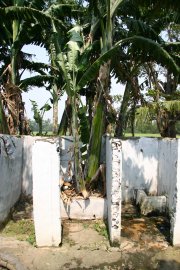 Other infrastructure projects include rehabilitating and constructing protected wells, improving village drainage systems, and improving garbage disposal systems, and in addition to this health education is circulated in the communities detailing hygienic practices such as the need to wash one's hands after using the toilet, before handling food etc.
Other infrastructure projects include rehabilitating and constructing protected wells, improving village drainage systems, and improving garbage disposal systems, and in addition to this health education is circulated in the communities detailing hygienic practices such as the need to wash one's hands after using the toilet, before handling food etc.
Each project is planned together; Care supports the programmes by providing materials and project expertise. The community contributes by providing expertise (when available), construction labour and long term management of the infrastructure.
After a quick return to the Tangerang office I was taken back to the city centre and was soon back in the middle of massive traffic jams of buses, trucks, scooters and cars. I immediately noticed that the standard of the cars in the city centre was unnaturally high, with many luxury saloons like BMW, Lexus etc. and this is a very disappointing indicator of the division of wealth in this country, which is still struggling to break free of the corruption institutionalised in the Soeharto regime. Part of me thinks that the Indonesian government should do more to help the Indonesian population but this is wishful thinking. Without organisations like Care International these people would continue to suffer health problems due to their poverty with the problem escalating as the urban population grows, so I strongly ask you help Care do their work in this and their other projects around the world by donating a small amount. Please stay in one evening and give the money to Care instead; it will directly improve the lives of people less fortunate than yourselves.
| All content copyright � overland-underwater.com - please do not use without permission. |
